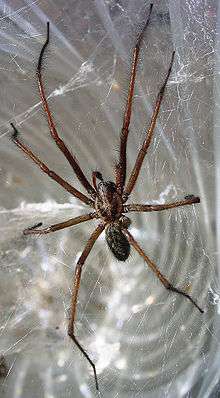Eratigena
Eratigena is a genus of spider in the family Agelenidae. Most of its species were moved from the genus Tegenaria in 2013. Two species that frequently build webs in and around human dwellings are now placed in this genus. Eratigena agrestis is the hobo spider, native to Europe and Central Asia, introduced to North America. Eratigena atrica is the giant house spider, native to Europe and also introduced into North America.
| Eratigena | |
|---|---|
 | |
| Eratigena atrica, the giant house spider | |
| Scientific classification | |
| Kingdom: | Animalia |
| Phylum: | Arthropoda |
| Subphylum: | Chelicerata |
| Class: | Arachnida |
| Order: | Araneae |
| Infraorder: | Araneomorphae |
| Family: | Agelenidae |
| Genus: | Eratigena Bolzern, Burckhardt & Hänggi, 2013[1] |
| Type species | |
| Tegenaria atrica | |
| Species | |
Taxonomy
Phylogeny
Species now placed in the genus Eratigena were previously placed in Tegenaria and Malthonica. In 2013, a study was carried out on European house spiders in the "Tegenaria-Malthonica complex". Using both morphological and molecular data, the study found four well-supported clades, one of which constituted a new genus Eratigena, comprising species formerly placed in Tegenaria and Malthonica.[2] The name Eratigena is an anagram of Tegenaria.[3] (Some Tegenaria species had previously been separated into the new genus Aterigena, another anagram of Tegenaria.[4])
Although the genera involved in the study were consistently found to be monophyletic, different analyses found different relationships among them.[2] Based on both morphological and DNA data, one hypothesis for the phylogeny of Eratigena and related genera is:[5]
| ||||||||||||||||||||||||||||
Identification
Bolzern et al. (2013) provide a key to the European agelenid genera. Eratigena can be differentiated from Malthonica by the un-notched trochanters on legs III and IV (notched in Malthonica). The genus differs from Tegenaria in the number and size of the teeth on the rear margin of the chelicerae. Eratigena has six or more teeth, with those closer to the body of the spider being smaller. Tegenaria has three to six large teeth, more or less equal in size.[6]
Species
As of April 2020, the World Spider Catalog accepted the following species:[1]
- Eratigena agrestis (Walckenaer, 1802) – Europe to Central Asia, introduced into USA and Canada (hobo spider)[7]
- Eratigena arganoi (Brignoli, 1971) – Italy
- Eratigena atrica (C. L. Koch, 1843) – Europe, introduced in North America (giant house spider)
- Eratigena balearica (Brignoli, 1978) – Balearic Is.
- Eratigena barrientosi (Bolzern, Crespo & Cardoso, 2009) – Portugal
- Eratigena blanda (Gertsch, 1971) – Mexico
- Eratigena bucculenta (L. Koch, 1868) – Portugal, Spain
- Eratigena caverna (Gertsch, 1971) – Mexico
- Eratigena decora (Gertsch, 1971) – Mexico
- Eratigena duellica (Simon, 1875) – Canada, US, Europe
- Eratigena edmundoi Bolzern & Hänggi, 2016 – Mexico
- Eratigena feminea (Simon, 1870) – Portugal, Spain, Madeira, Algeria
- Eratigena fernandoi Bolzern & Hänggi, 2016 – Mexico
- Eratigena flexuosa (F. O. Pickard-Cambridge, 1902) – Mexico
- Eratigena florea (Brignoli, 1974) – Mexico
- Eratigena fuesslini (Pavesi, 1873) – Europe
- Eratigena gertschi (Roth, 1968) – Mexico
- Eratigena guanato Bolzern & Hänggi, 2016 – Mexico
- Eratigena herculea (Fage, 1931) – Spain, Ibiza
- Eratigena hispanica (Fage, 1931) – Spain
- Eratigena incognita (Bolzern, Crespo & Cardoso, 2009) – Portugal
- Eratigena inermis (Simon, 1870) – Portugal, Spain, France
- Eratigena laksao Bolzern & Jäger, 2015 – Laos
- Eratigena mexicana (Roth, 1968) – Mexico
- Eratigena montigena (Simon, 1937) – Portugal, Spain
- Eratigena picta (Simon, 1870) – Europe, Russia, North Africa
- Eratigena queretaro Bolzern & Hänggi, 2016 – Mexico
- Eratigena rothi (Gertsch, 1971) – Mexico
- Eratigena saeva (Blackwall, 1844) – Western Europe, Canada
- Eratigena sardoa (Brignoli, 1977) – Sardinia
- Eratigena selva (Roth, 1968) – Mexico
- Eratigena sicana (Brignoli, 1976) – Sicily, Sardinia
- Eratigena tlaxcala (Roth, 1968) – Mexico
- Eratigena vidua (Cárdenas & Barrientos, 2011) – Spain
- Eratigena vomeroi (Brignoli, 1977) – Italy
- Eratigena xilitla Bolzern & Hänggi, 2016 – Mexico
- Eratigena yarini Bolzern & Hänggi, 2016 – Mexico
See also
References
- "Gen. Eratigena Bolzern, Burckhardt & Hänggi, 2013", World Spider Catalog, Natural History Museum Bern, retrieved 2020-04-01
- Bolzern, Burckhardt & Hänggi (2013), pp. 736–738
- Bolzern, Burckhardt & Hänggi (2013), p. 738
- Bolzern, Angelo; Hänggi, Ambros & Burckhardt, Daniel (1 August 2010), "Aterigena, a new genus of funnel-web spiders, shedding some light on the Tegenaria-Malthonica problem (Araneae, Agelenidae)" (PDF), The Journal of Arachnology, 38 (2): 162–182, doi:10.1636/A09-78.1, JSTOR 20788609, archived (PDF) from the original on 3 December 2018
- Bolzern, Burckhardt & Hänggi (2013), p. 753
- Bolzern, Burckhardt & Hänggi (2013), p. 739
- Bolzern, Burckhardt & Hänggi (2013), pp. 723
Bibliography
- Bolzern, Angelo; Burckhardt, Daniel & Hänggi, Ambros (26 July 2013), "Phylogeny and taxonomy of European funnel-web spiders of the Tegenaria−Malthonica complex (Araneae: Agelenidae) based upon morphological and molecular data", Zoological Journal of the Linnean Society, 168 (4): 723–848, doi:10.1111/zoj.12040